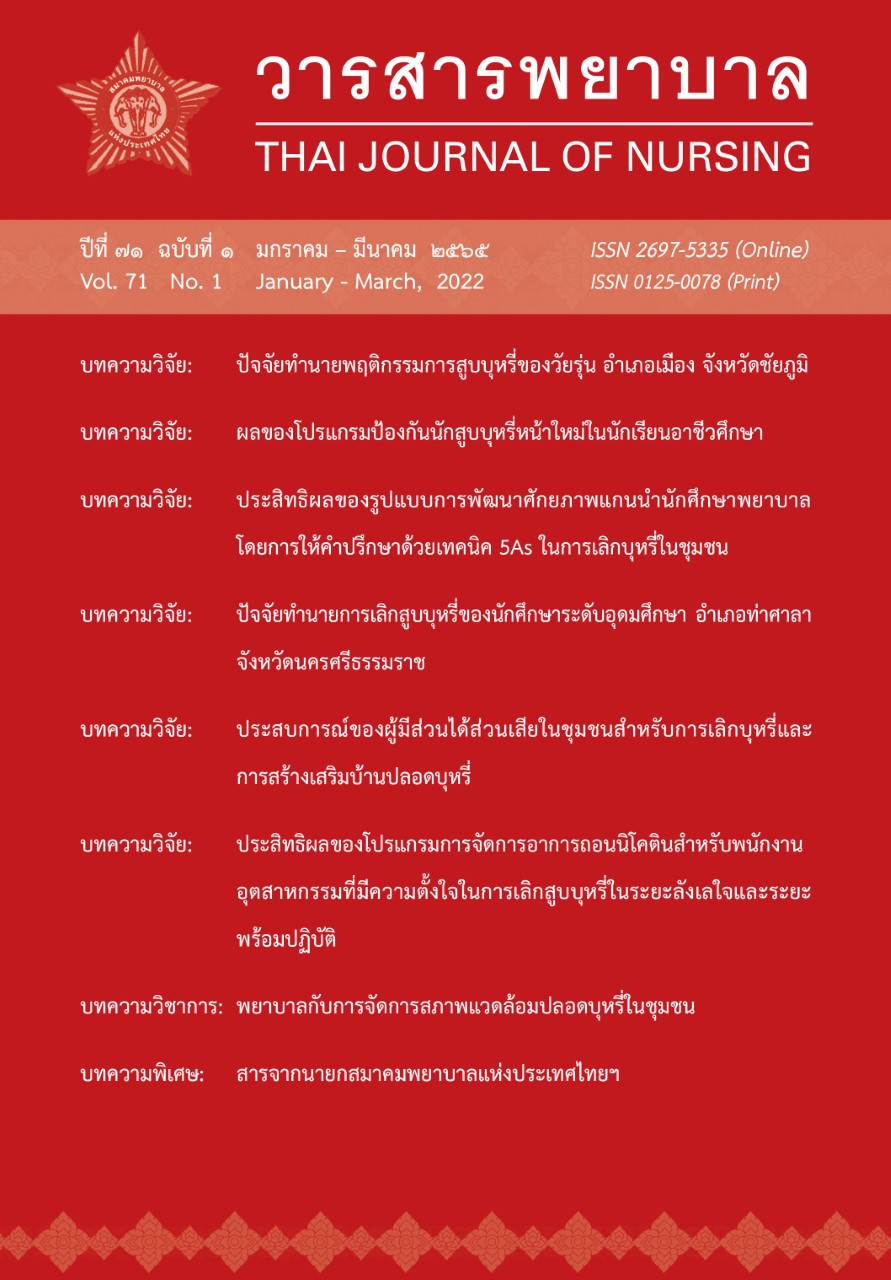Stakeholders’ experience in community for smoking cessation and promotion of smoke-free home
Main Article Content
Abstract
The purpose of this qualitative research was to study the experiences of stakeholders in community for smoking cessation and promotion of smoke-free home. The participants were smokers, families of smokers at home, community leaders, and registered nurses. A total of 24 informants was purposively selected from those with experience in tobacco control. Data were collected using a focus group guideline. Data were analyzed by content analysis. The results showed that quitting smoking and promoting smoke-free homes were as follows. 1) Motivating and adjusting attitudes, 2) assessing the 5As, intention to quit, and the stage of change, 3) creating a smoke-free environment for the health of the people. However, the home must be strictly smoke-free and professional nurses take care of family health, and 4) the community has sustained continuous participation with community policies building a network of cooperation with internal and external communities including strengthening the community and continuing to be sustainable.
Article Details

This work is licensed under a Creative Commons Attribution-NonCommercial-NoDerivatives 4.0 International License.
References
ชมนาด พจนามาตร์, โสภาพรรณ อินต๊ะเผือก, พงษ์ภัทร์ รัตนสุวรรณ, บุบผา วิริยรัตนกุล, นภมน ยารวง,
ขนิษฐา พิศฉลาด, และมัลลิกา มาตระกูล. (2563). การจัดการเรียนการสอนเพื่อควบคุมการบริโภค
ยาสูบ: หมวดวิชาการสร้างเสริมสุขภาพ (พิมพ์ครั้งที่ 2). นนทบุรี: สื่อตะวัน.
ธนะวัฒน์ รวมสุก, ณิชมน หลำรอด, และบุญทิพย์ ลิขิตพงษ์วิทย์. (2563). บทบาทพยาบาลเวชปฏิบัติชุมชน
กับการช่วยเลิกบุหรี่ในผู้ป่วยโรคไม่ติดต่อเรื้อรัง. วารสารพยาบาล, 70(1), 34-42.
สุปาณี เสนาดิสัย, และสุรินธร กลัมพากร. (2563). บุหรี่กับสุขภาพ: พยาบาลกับการควบคุมการบริโภค
ยาสูบ (พิมพ์ครั้งที่ 3). นนทบุรี: สื่อตะวัน.
สำนักควบคุมการบริโภคยาสูบ. (2564). แผนงานควบคุมการบริโภคยาสูบ ปี 2560-2564. สืบค้นเมื่อ 1
พฤศจิกายน 2564, จาก www.http://plan.ddc.moph.go.th.
Action on Smoking and Health Foundation. (2015). Secondhand smoke in the home. Retrieved January
, 2021, from https://ash.org.uk/wp-content/uploads/2019/10/SecondhandSmoke-Home.pdf
Aurrekoetxea, J. J., Murcia, M., Rebagliato, M., Guxens, M., Fernandez-Somoano, A., Lopez, M. J,…
Santa-Marina, L. (2016). Second-hand smoke exposure in 4-year-old children in Spain: Sources,
associated factors and urinary cotinine. Environmental Research, 145, 116-125. doi: 10.1016/j.
envres.2015.11.028
Bialous, S. A., Nohavova, I., Kralikova, E., Wells, M. J., Brook, J., & Sarna, L. (2020). Building capacity
in tobacco control by establishing the Eastern Europe Nurses' Center of Excellence for Tobacco
Control. Tobacco Prevention & Cessation, 6, 68. doi: 10.18332/tpc/128190
Chitasombat, P. (1998 ). Brain mechanisms involved in drug addiction (in Thai). Journal of the
Psychiatrist Association of Thailand, 43(2), 150-158.
Esen, A. D., Soylem, Y., Arica, S., Belgin, G., & Gonultas, N. (2020). Factors affecting success and
abstinence within a smoking cessation clinic: A one-year follow-up study in Turkey. Tobacco
Prevention & Cessation, 6, 1-8. doi: 10.18332/tpc/130471
Fischer, F., & Kraemer, A. (2017). Secondhand smoke exposure at home among middle and high school
students in the United States - does the type of tobacco product matter? BMC Public Health, 17(1),
-8. doi: 10.1186/s12889-017-4019-z
Gallus, S., Lugo, A., Gorini, G., Colombo, P., Pacifici, R., & Fernandez, E. (2016). Voluntary home
smoking ban: prevalence, trend and determinants in Italy. European Journal of Public Health,
(5), 841-844. doi: 10.1093/eurpub/ckw146
HFocus. (2022). Focus on health system. Retrieved February 15, 2022, from
https://www.hfocus.org /content/2019/01/16778
Kim, D., Choy, Y. S., & Park, E. C. (2017). Association between secondhand smoke and glycemic
control in adult diabetes patients. Preventive Medicine, 94, 48-54. doi: 10.1016/j.ypmed.2016.11.009
Kumar, R., & Prasad, R. (2014). Smoking cessation: An update. The Indian Journal of Chest Diseases
and Allied Science, 56(3), 161-169.
Mak, Y. W., Loke, A. Y., & Wong, F. K. Y. (2018). Nursing intervention practices for smoking
cessation: A large survey in Hong Kong. International Journal of Environmental Research and
Public Health, 15(5), 1-14. doi: 10.3390/ijerph15051046
Mansour, A. Y. (2017). Determinants of willingness to accept secondhand smoke exposure. American
Journal of Health Behavior, 41(5), 571-578. doi: 10.5993/AJHB.41.5.6
Maulana, M., Jatmika, S. E. D., Kuntoro, Martini, S., Widiarti, S., & Azizah, S. N. (2020). Smoke-free
home program with number of cigarettes in Yogyakarta. Advances in Health Sciences Research, 22,
-402.
Saito, J., Shibanuma, A., Yasuoka, J., Kondo, N., Takagi, D., & Jimba, M. (2018). Education and indoor
smoking among parents who smoke: The mediating role of perceived social norms of smoking.
BMC Public Health, 18(211), 1-12. doi: 10.1186/s12889-018-5082-9
Suteerangkul, P., Lagampan, S., Auemaneekul, N., & Kalampakorn, S. (2019). Thai community
perspectives on suburban smoke-free homes: Qualitative findings from a mixed method study.
Pacific Rim International Journal of Nursing Research, 23(2), 106-117. doi: https://he02.tci-
thaijo.org/index.php/PRIJNR/article/view/121040
World Health Organization. (2021). Tobacco factsheets. Retrieved October 20, 2021, from
https://www.who.int/news-room/fact-sheets/detail/tobacco
World Health Organization. (2022). Smoking rates by country. Retrieved February 15, 2022, from
https://worldpopulationreview.com/country-rankings/smoking-rates-by-country


